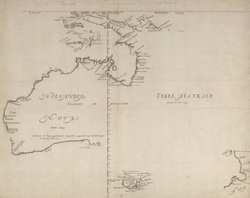1820–1829
In 1820, Tasmanian roads were first macadamised and carthorses began to replace bullocks. In the same year, the first substantial jail was completed on the corner of Macquarie Street and Murray Street; and merino sheep arrived from John Macarthur's stud in New South Wales. 1820 also saw the first Wesleyan (Methodist) meeting in the colony. The following year marked the arrival of the first Catholic clergyman, Father Phillip Conolly; and on his second visit, Governor Lachlan Macquarie chose sites for Perth, Campbell Town, Ross, Oatlands, Sorell and Brighton. In 1821, officials and convicts left Port Dalrymple to establish Macquarie Harbour penal settlement at Sarah Island.
1822 was the first year Van Diemen's Land Agricultural Society held a meeting in Hobart. In 1823 the Presbyterian Church's first official ministry in Australia occurred in Hobart and the first Tasmanian bank, Bank of Van Diemen's Land, was established.
The inauguration of the Supreme Court occurred in 1824, as did the opening of Cascade Brewery, Australia's longest continuously operating Brewery. Convict Alexander Pearce was hanged after escaping twice from Macquarie Harbour and surviving by eating his companions. Convict Matthew Brady began his bushranging career after escaping from Macquarie Harbour.
On 3 December 1825, Van Diemen's Land became independent from New South Wales with an appointed Executive Council, its own judicial establishment, and Legislative Council. Also in that year, the Richmond Bridge, Australia's oldest existing bridge, was opened; and a party of soldiers and convicts established Maria Island penal settlement
In 1826, Van Diemen's Land Company launched the North-West pastoral and agricultural development at Circular Head; and the Tasmanian Turf Club was established. Settler John Batman, later one of Melbourne's founders, helped capture bushranger Matthew Brady near Launceston. Hobart experienced a disease epidemic which was blamed on rivulet pollution. A courthouse was built on the corner of Macquarie Street and Murray Street; and street lighting with oil lamps was introduced. 1826 was also the year that the Legislative Council met formally for the first time.
1827 saw the first regatta-style events on Derwent River; and Van Diemen's Land Company began settlement at Emu Bay (now Burnie).
A proclamation made in 1828 by Lieutenant-Governor George Arthur excluded Aboriginal people from settled areas and was the year of the Cape Grim massacre. In 1828, martial law was also declared against Aboriginal people in settled areas after Van Diemen's Land Company shepherds killed 30 Aboriginal people at Cape Grim. Regular mail services to and from Sydney began. That year also saw widespread floods. The following year a jail for women convicts ("female factory") opened at Cascades; "Protector" George Augustus Robinson started an Aboriginal mission at Bruny Island, convicts seized the brig Cyprus at Recherche Bay and sailed to China; Van Diemen's Land Scientific Society was formed under patronage of Lieutenant-Governor George Arthur; and a Hobart-New Norfolk coach service began.







